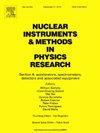The MUSE beamline calorimeter
IF 1.4
3区 物理与天体物理
Q3 INSTRUMENTS & INSTRUMENTATION
Nuclear Instruments & Methods in Physics Research Section A-accelerators Spectrometers Detectors and Associated Equipment
Pub Date : 2025-07-03
DOI:10.1016/j.nima.2025.170754
引用次数: 0
Abstract
The MUon Scattering Experiment (MUSE) was motivated by the proton radius puzzle arising from the discrepancy between muonic hydrogen spectroscopy and electron–proton measurements. The MUSE physics goals also include testing lepton universality, precisely measuring two-photon exchange contribution, and testing radiative corrections. MUSE addresses these physics goals through simultaneous measurement of high precision cross sections for electron–proton and muon–proton scattering using a mixed-species beam. The experiment will run at both positive and negative beam polarities. Measuring precise cross sections requires understanding both the incident beam energy and the radiative corrections. For this purpose, a lead-glass calorimeter was installed at the end of the beam line in the MUSE detector system. In this article we discuss the detector specifications, calibration and performance. We demonstrate that the detector performance is well reproduced by simulation, and meets experimental requirements.
MUSE光束线量热计
介子散射实验(MUSE)是由介子氢光谱与电子-质子测量值之间的差异所引起的质子半径之谜所激发的。MUSE的物理目标还包括测试轻子普适性,精确测量双光子交换贡献,以及测试辐射校正。MUSE通过使用混合光束同时测量电子-质子和介子-质子散射的高精度截面来解决这些物理目标。实验将在正负两种光束极性下进行。测量精确的横截面需要了解入射光束能量和辐射修正。为此,在MUSE探测器系统的光束线末端安装了铅玻璃量热计。本文讨论了探测器的规格、校准和性能。仿真结果表明,该探测器的性能可以很好地再现,满足实验要求。
本文章由计算机程序翻译,如有差异,请以英文原文为准。
求助全文
约1分钟内获得全文
求助全文
来源期刊
CiteScore
3.20
自引率
21.40%
发文量
787
审稿时长
1 months
期刊介绍:
Section A of Nuclear Instruments and Methods in Physics Research publishes papers on design, manufacturing and performance of scientific instruments with an emphasis on large scale facilities. This includes the development of particle accelerators, ion sources, beam transport systems and target arrangements as well as the use of secondary phenomena such as synchrotron radiation and free electron lasers. It also includes all types of instrumentation for the detection and spectrometry of radiations from high energy processes and nuclear decays, as well as instrumentation for experiments at nuclear reactors. Specialized electronics for nuclear and other types of spectrometry as well as computerization of measurements and control systems in this area also find their place in the A section.
Theoretical as well as experimental papers are accepted.

 求助内容:
求助内容: 应助结果提醒方式:
应助结果提醒方式:


